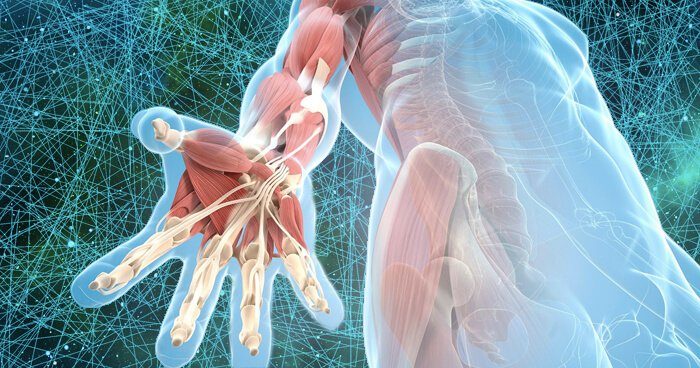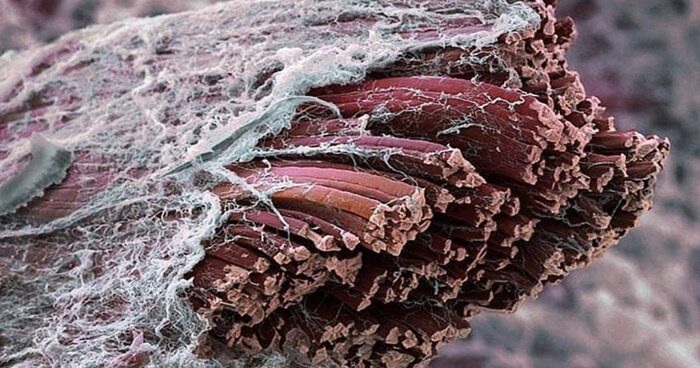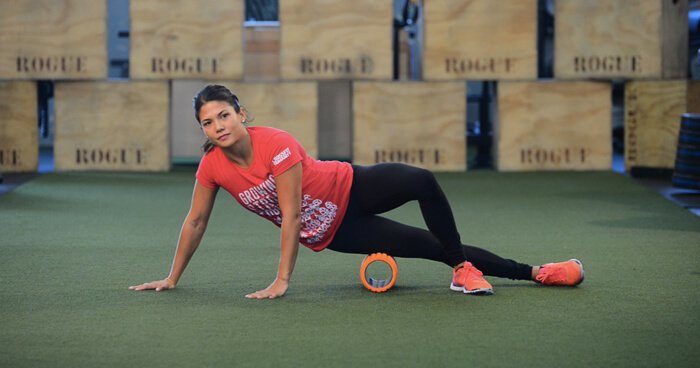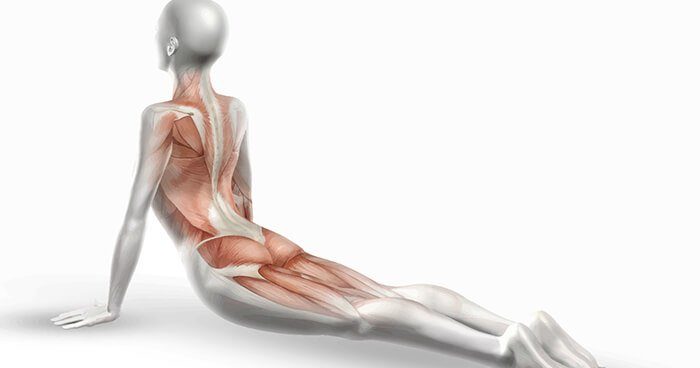Once you've experienced the aha moments that accompany practices that release the body's fascia, there's no going back. You know it. A subtle shift. A feeling of letting go. Maybe you haven't been able to describe it in words. It's an experience that needs to be felt. But you know it. You may have felt it in a hip opener or a backbend. The moment your body goes from resisting to releasing. It's the thing that keeps us coming back to our yoga mats; it's all about fascia.
Anatomy expert and author of Anatomy Trains, Tom Myers, when describing fascia tells us that, basically, our cells "are glued together with snot, which is everywhere, and is more or less watery (hydrated) depending on where it is in the body and what condition it's in."
The wonderful thing about the journey to understanding fascia is that you don't need to have an acute understanding of the ins and outs of anatomy in order to see how it operates within your body. I recently attended a fitness class at the gym titled 'fascial fitness'. Long journeys along foam rollers were intercepted by oscillating movements that left me feeling spacious and free-despite the pop music in the background and lack of savasana at the end of the class.
As the research on fascia evolves, we learn new ways of unravelling deeply held tensions in this connective tissue, which greatly impacts our mobility as we age, as well as affecting our mind. And although we yogis often hear the word fascia associated with yin yoga, Western science is continuing to discover new ways of releasing and rehydrating through different forms of movement.
Fascia, Simply
Author of Fascia-What it is and why it matters David Lesonak, explains that fascia is like "a silvery-white material, flexible and sturdy in equal measure-a substance that surrounds and penetrates every muscle, coats every bond, covers every organ, and envelops every nerve." He says:
The most important thing to keep in mind... is that the fascial net is one continuous structure throughout the body...The 'everywhereness' of fascia also implies that, indeed, it is all connected, and thus is 'connective tissue', which is a term often used interchangeably with 'fascia.'The Connective Tissue that Weaves Through Us All
Ariele Foster is the founder of Yoga Anatomy Academy. She's also a personal trainer, yoga teacher and anatomy teacher for yoga teacher trainings. Foster explains that fascia is "the network of connective tissue that surrounds and includes your muscles - like scaffolding throughout your whole body. While the fibres of your body are supposed to slide easily over one another during movement, that's not always exactly how it happens. "Whether due to injury or repetitive actions [such as running, hunching over computers, or even yoga poses] areas of tissue can become thickened and inflamed and tug on fascial networks further up the chain," Foster says. The result of these repetitive movements is that "the fascial sheaths that encase the muscles no longer have as much give and can become wound up like a wrung-out dishrag, contributing to restrictions, strain, and eventually pain."
Erin Bourne holds a Bachelor of Exercise Science, as well as extensive training in Yoga and Myofascial release. She describes fascia as a dynamic and highly sensitive tissue that's always listening and responding to what is happening throughout the whole body.
If we stop moving one part, or all, of the body then the fascia starts to dehydrate, solidify and constrict. This spot becomes like a dam for the energy, the information and the signals. We lose awareness in that part of the body and healthy function.By including exercises that help to release the fascia, Foster says, "we improve the slide and glide of the tissues whilst hydrating them through the act of compression and release." And by doing this in one part of the body, it affects the whole. So, for example, if we release (or restrict) the fascia in the feet, it can have an impact all the way up to our neck.

According to eastern philosophies, energy flows through fascia. In The Spark in the Machine: How the Science of Acupuncture Explains the Mysteries of Western Medicine, Daniel Keown says, "Fascia is everywhere-controlling everything; forming our body; channeling Qi; keeping everything in order." Keown explains that the acupuncture channels of the East are the fascial planes of the West, and Western science is beginning to support these philosophies as it discovers parallels between the anatomy trains and the meridians.
Releasing Fascia
Research on fascial release shows that there are a number of ways that we can start to unravel the deeply held tensions that lead to constriction and pain in our bodies and minds.
Tom Myers has been involved in bodywork for over 43 years. He is the author of the hugely popular Anatomy Trains and also lectures on the topic of fascia. He explains that we need long, slow stretches in order to reach the deeper and denser tissues of the body, such as fascia. He says:
One of the wonderful things about yoga is that because of the sustained stretch held in many yoga poses, you actually do change the connective tissue.For Myers, once you change the habitual patterns of the fascia, you can start to address the chronic tension lodged in the tissues. The long held poses of yoga, especially yin, give the muscles time to relax and release, which can ultimately lead to both physical and emotional healing. Myers explains that when you first stretch a muscle, its own stretch reflex tries to contract the muscle back to its original length, but maintaining the stretch allows the body to relax into the shape and as the muscles relax, we begin to work into the deeper layers, like fascia.
The muscles have to relax first and then the fascia starts to stretch and release. And that can facilitate the kind of re-patterning that leads to lasting release of chronic holdings and, in many cases, a profound change of mind and body.Myers notes that there is no amount of time that works for every body. For some, physiological changes can happen in a short time, and for others, long-held poses are required for release. It's also important that we don't push ourselves to our full capacity, so that we remain fluid; subtly moving within a pose to allow optimal hydration of the fascia.
Foster points to a 2015 review in the International Journal of Sports Physical Therapy that looks at 14 scientific papers illustrating the positive impacts of fascia release exercises. The studies suggested that gently rolling different muscles over balls or foam rollers (like in the newly popular 'Yoga Tune Up' classes) "pushes on fascia between your bones, muscles, organs, and nerve fibres-freeing up more mobility than is achievable with passive stretching alone."
Fascia, Feelings, and Letting Go
Alexa Nehter is a long time yoga teacher who has delved deeply into the fascinating world of fascia. She's studied with Tom Myers and has been blessed with the opportunity to meet with Dr Robert Schleip, one of the most well known fascia experts in the world and director of the Fascia Research Project at the University of Ulm, in Germany. Nehter muses about her love affair with fascia: "Fascia is our biggest sensory organ, our organ of awareness, our internal ocean. For me the current fascia research brings everything together with what I've learned through surfing, meditation and yoga."
Foster tells us that impacting our fascia can affect our nervous system. She says, "Gentle pressure on your fascia may help communicate to your nervous system that there is no longer any need for increased tension in that area." And so, by influencing these deeply held tensions in one part of the body, we can start to not only unravel and release tension in other parts of the body, but also in the mind.
Nehter understands wholeheartedly. She explains how her life changed when she began exploring the world of intuitive fascial movement.
I began to undo the knots and complications in my life that had been getting bigger and increasingly restrictive.By exploring fascial release, and the movements and practices associated with it, Nehter explains, "you'll notice the places where your body is holding on at a deeper level than your muscles or connective tissue." She says:
You learn to feel the fast and slow vibrations of your neurological patterning, and, when you allow yourself to let go and open even deeper, you notice these openings giving way to your life force... Interoceptive movement teaches us higher sensitivity and, the more sensitive we are, the deeper the patterns we are able to unwind. The more we do that, the more freedom, love and passion for life we can experience.There are a number of ways in which we can release, hydrate and revitalise fascia, leading to profound changes in the body and mind, and while the research continues to unveil these methods, our own body's intuition can also certainly point us in the right direction.
When we're practicing yin, we can feel the moment when resistance subsides-a gentle unlocking in the body's holding reminds us to soften. When we're rolling around on balls in a Tune Up class, we sense our body surrendering. And when we glide our quads along foam rollers, we feel the tension slowly increasing, until it releases and we can finally breathe and let go. That's the magic of fascia, and it's only the beginning.







Comment: For a more in-depth discussion of methods to release tension and stored emotions in the body, see: The Health & Wellness Show: Body Work: The Issues in Your Tissues
See also: